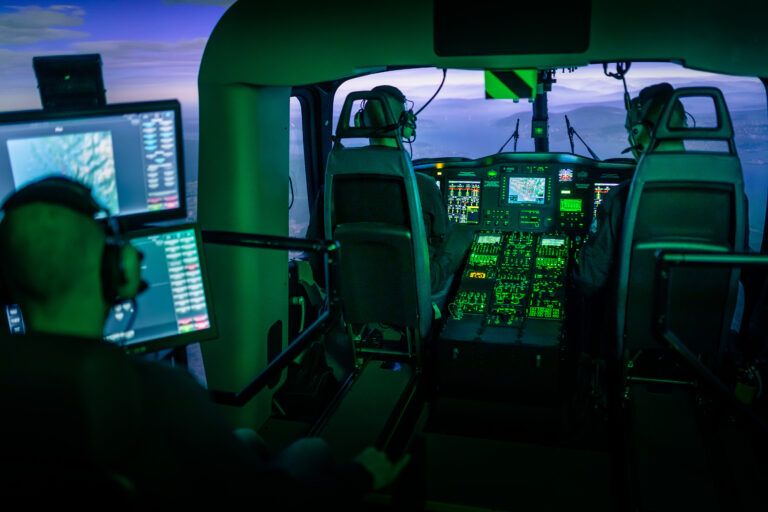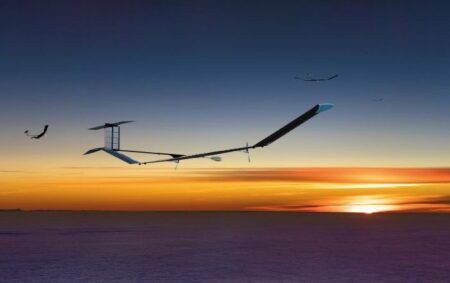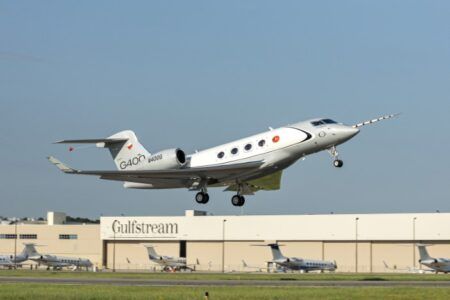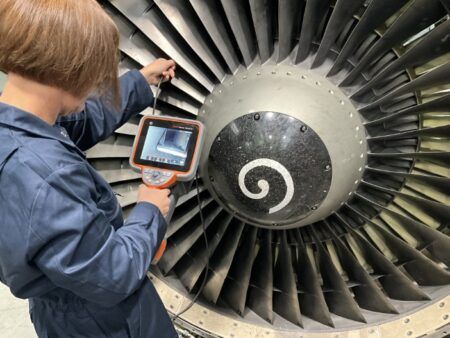Words by Glenn Sands
The use of high-fidelity graphics and ejection seat motion sensors are creating a new level of realism that can ‘fool’ pilots during training.
The levels of realism achievable in aircraft simulators is such that many pilots now emerge from a simulator session exhausted, sweaty palmed and wondering if they may have damaged the aircraft. But the sector is still striving to increase the levels of realism with new technological approaches that may remove the multi-million dollar six-point gimbal mounted simulators forever.
David Smith, senior vice president and general manager for TRU Simulation and Training says, “The industry needs to shift beyond what it regards as the necessary minimal thresholds which commercial crews have to meet. Everyone can be made better, even a
high-time pilot can have their techniques improved.
“A simulator is intended to prepare pilots for something that they haven’t seen before, or for cockpit software issues that are presented in a way they haven’t seen before.”
Helicopter kick
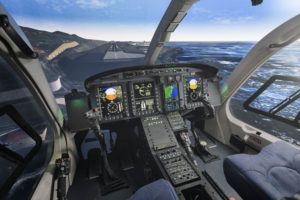
As one of the world’s leading manufacturers of helicopter simulators, TRU is determined to provide the safest, most-realistic and cost-effective rotorcraft training solutions around the world.
“In commercial helicopter operations we identified that you spend a lot of time flying low to the ground, flying on visual flight rules and completing a lot of safety and mission critical tasks,” says Smith. “For example, in hoisting and cargo hook work where precision and control are crucial the need to replicate this in a simulation is critical, including the vibration and
micro-cues for the pilot.
“To achieve this within a Level D helicopter simulator we incorporate a dual motion system. The primary motion system provides the acceleration and orientation of the aircraft, while the secondary motion system provides the six-degrees of freedom and vibration to the controls.”
Two motion systems in the simulator enables a greater degree of realism in the case of engine failure, where the kick of autorotation has always been difficult to replicate in training. The ability to train a pilot when they only have a millisecond to respond, repeatedly, with no risk to life or equipment, has become the core motivation for TRU.
Level D is the highest standard of simulator. It offers full motion and the highest fidelity possible. Typical customers will be in the oil and gas sector operating an Airbus H135. The main benefit for the customer is a reduction in costs, along with less wear on the aircraft and less hours used up on training flights. But with the average simulator taking up to 12 months to prepare for a client and taking into account the cost, smaller helicopter operators such as those flying the new Bell 505, have an alternative option.
Smith says, “For lighter aircraft, we have a fixed based device, but ours still has a small degree of motion dialed into the vibration spectrum, so it gives a relatively low-cost approach to training. The benefit is that you don’t need as much space and you get the same immersive visuals as you would in a larger system.
“When any pilot is flying, they are not going to put their aircraft at risk. The first job is to keep that aircraft safe and the second is training. In our simulators we do the opposite. The first thing is training and that’s the only thing.”
Simulator development
All of TRU’s simulators follow a similar development path by gathering as much flight test data as possible. The samples have to be fast. Rates of around hundred times per second in data acquisition is the minimum. “But here lies a fundamental problem,” says Smith. “The manufacturer has only flown the prototype in certain maneuvers or specific weight configurations, so pilots play a huge role in making the quality aspect within the simulator – their opinion adds value to the whole package.
“A pilot will fly a certain maneuver, perhaps one they have flown a thousand times before in a real aircraft. Then they sit in the simulator and say, ‘look this feels slightly off’, and perhaps the flight controls are not quite where they would be in a real machine. We check against our own flight test data. If we can see the variable then we fix it. You need that additional layer of pilot context when developing these kinds of systems.”
TRU is currently developing a search and rescue (SAR) simulator that replicates the cockpit and the rear cabin for the winch operator. Both work in unison and simulate the feeling and full motion during a typical rescue scenario. The type of ship and sea state can also be recreated and even scenarios such as engine failure during a rescue.
Centrifugal struggle
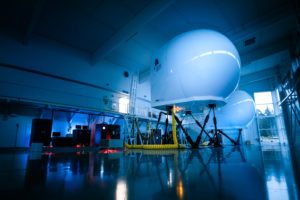
While such technical advances fuel uptake in the industry, the use of expensive six-dot simulators may be coming to an end in training future military fast jet pilots. Paul Hutton, CEO of Cranfield Aerospace Solutions, foresees a far simpler, cost-effective way.
“If you think of a military fast jet pilot, they do a lot of long duration high-g maneuvers. If you put them in a simulator similar to that used for a commercial pilot, you can simulate the onset of g-force, but it can’t really replicate the environment a military pilot operates in,” says Hutton.
For a military pilot, the only way of simulating a realistic sustained g-force is to spin them in a centrifuge. Although it’s very good for physiological effects, it’s not good for operational training. Engineers at Cranfield have developed an innovative system capable of fooling the pilot’s brain into experiencing g-force. Hutton says, “We do this by starting with a standard replica ejection seat, inserting high fidelity actuators, pressure sensors under the seat cushion and on the back and then we move the seat up and down a few centimeters so that the pilot’s eye line will alter slightly to give them a sense of movement. The seat harnesses compress the spine to simulate the onset of g-force and the G-suit inflates and deflates.
“All of this is closely aligned with the simulator movement of the aircraft and coordinated with the pilot’s input. It quickly confuses the brain into thinking it is feeling g-force and once you have confused the brain you can sustain the forces for longer.”
This is a technique known as g-cueing and for pilots it is the closest effect achievable to real flight. Hutton says, “The advantage is that it can be accomplished with nothing more than an ejection seat and some boxes mounted behind the seat structure. It’s a very compact training environment.
“This can be inserted into a normal military full-motion simulator to add the full wrap-around visual environment or you put on a virtual reality helmet and the seat will still provide the motion cueing via the helmet.”
The potential benefits of the last set-up mean, due to the compactness of the seat, you could have six of these next to each other with pilots from the same unit flying together in a virtual world. Seated opposite them could be an opposing force of six pilots. All would be wearing VR helmets and would gain the same benefits of a six-dot simulator at far less cost and space. The leap in technology is expected soon. Hutton says, “Some of the fourth and fifth generation fighters are supplied with helmets which are effectively projection systems, producing an operational picture during a real flight. It’s a short step for one of the OEM integrators to develop software that will integrate the helmet into our seat technology.
“The future military fast jet simulator might be where a pilot brings their helmet, plugs it into our seat and is in a fully immersive training environment. No one has done this yet. You’ve got both the seat and helmet developed and it’s a case of integrating them.”
Surprisingly, the present F-35 simulator trainer is a fixed seat with screens in front which is decades old in terms of simulation technology. It’s very easy to give future F-35 pilots a fully immersive training environment at very little cost using some of the personal kit they already have. Hutton says, “It’s important that the military wakes up to this approach because aircraft, like the F-35, have no two-seat trainers. When a pilot climbs into the aircraft for the first time, they are on their own, so the quality of the synthetic training they have had prior to this becomes even more critical.”
This article was originally published in the March 2020 issue of Aerospace Testing International magazine. View in its original format here. Subscribe to the quarterly magazine for free here and to the weekly newsletter here.


